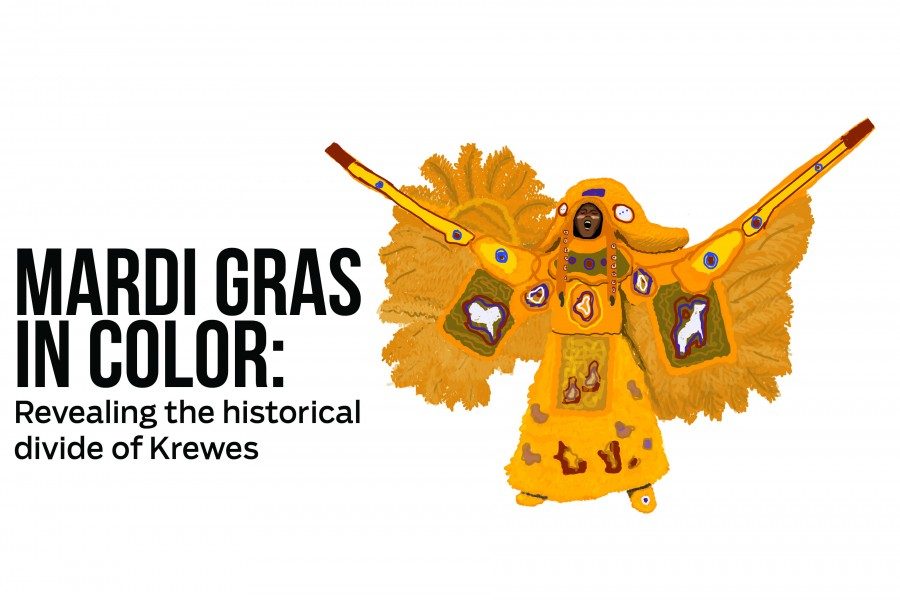Mardi Gras in color: revealing the historical divide of krewes
Each carnival season, the city of New Orleans shuts down for perhaps it’s oldest and most famed event: Mardi Gras. Most people know of krewes from their parades and the distinct types of Mardi Gras throws they toss into the cheering crowds along St. Charles Avenue.
Krewes, however, are more than the people that make up the parades. They are social groups that host events and balls throughout the year. For most of their histories, many krewes, particularly the most exclusive and elite of the city, were intended only for white people.
It took until 1992 for the city to pass an ordinance desegregating New Orleans krewes and making it illegal for a segregated krewe to participate in Mardi Gras. Some of the most notorious krewes such as the Mystick Krewe of Comus, the Knights of Momus, Proteus and Rex were historically exclusively white males.
The impact of historically white krewes has been felt by New Orleanians attending parades for decades. Some New Orleans natives experienced the days when krewes, and most of the United States, were still heavily segregated and discriminatory toward African-Americans.
“It was very prejudiced when I was coming up,” Clara Simpson, an Uptown New Orleans native who grew up during a time of heavy racial discrimination in the 1930s and 40s, said. “Blacks couldn’t join their clubs.”
The experiences of individuals like Simpson may contrast from what many believe Mardi Gras stands for today. Tulane students from many backgrounds leave Mardi Gras season and recount positive interactions with members of krewes, often burdened only by the large amounts of beads and throws they caught. In the past, however, some experienced a different and less inclusive Mardi Gras.
“When they saw a group of white people, they would always throw them beads, but if you were black, maybe you would only leave with one or two because they would never throw them to you,” Simpson said. “… The only thing black people were allowed to do is help with the flambeaus and the horses, and the white would be on the floats. We didn’t get to ride the floats.”
After the legal desegregation of krewes, many clubs decided to refrain from participating in Mardi Gras altogether. In 1992, the Krewe of Comus and the Knights of Momus, which were both all-white male krewes, chose to not parade rather than integrate.
While some krewes were committed to their racial exclusion, other groups act as representation for the African-Americans once excluded from krewes and continue to parade today as integrated clubs.
“I don’t think black people really have an interest now to be a part of the white-dominated clubs like Endymion,” Korey Finnie, Tulane sophomore and New Orleans native, said. “We’ve created our own now, like Nomtoc and Zulu.”
The Krewe of Zulu, one of the most notable krewes in New Orleans, originated with members coming from aid societies, clubs and other organizations in the local African-American community. Because of its demographic, Zulu was discriminated against for a long period of time and was only allowed to parade in the “back streets” of black neighborhoods instead of the main streets such as St. Charles Avenue.
Another notable but lesser known organization is the New Orleans Most Talked Of Club or NOMTOC, an all-black krewe operating in the Algiers neighborhood. The krewe was established by a group of men named the Jugs Social Club, known for their contributions to local schools, social programs and college scholarships awarded to students from Algiers.
In many ways, krewes still lack diversity and their members reflect the racial composition of membership before 1992. Persistent segregation, however, is an issue in New Orleans that extends beyond the city’s famous carnival season.
“It’s a microcosm of the whole city,” Finnie said. “The city is segregated. Look at the schools. If you look at schools like my high school, it was 97 percent black. Then you have private schools that are like 90 percent white. It’s a segregated city. That’s the fabric of the city.”
Despite the racial separation that is seen during carnival season and throughout the city, Mardi Gras is still a time that many enjoy and look forward to year round.
“When you’re from here, you understand that everybody’s here, and everyone’s together,” Finnie said. “It’s the time that people come together. Mardi Gras is not about anything but enjoying yourself.”
Your donation will support the student journalists of Tulane University. Your contribution will allow us to purchase equipment and cover our annual website hosting costs.

















Leave a Comment